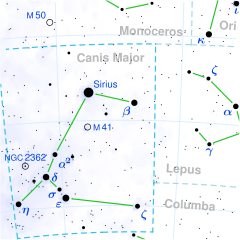Theta Canis Majoris (θ Canis Majoris) is a solitary,[7] orange-hued star near the northern edge[8] of the constellation Canis Major, forming the nose of the "dog".[9] The star is visible to the naked eye with an apparent visual magnitude of 4.08.[2] Based upon an annual parallax shift of 12.51 mas as seen from Earth,[1] it is located about 260 light years from the Sun. The star is moving away from us with a radial velocity of +96.2 km/s.[4]
| Observation data Epoch J2000.0 Equinox J2000.0 (ICRS) | |
|---|---|
| Constellation | Canis Major |
| Right ascension | 06h 54m 11.39877s[1] |
| Declination | −12° 02′ 19.0674″[1] |
| Apparent magnitude (V) | 4.08[2] |
| Characteristics | |
| Spectral type | K4 III[2] |
| U−B color index | +1.69[3] |
| B−V color index | +1.43[3] |
| Astrometry | |
| Radial velocity (Rv) | +96.2±0.1[4] km/s |
| Proper motion (μ) | RA: −137.26[1] mas/yr Dec.: −15.37[1] mas/yr |
| Parallax (π) | 12.51 ± 0.62 mas[1] |
| Distance | 260 ± 10 ly (80 ± 4 pc) |
| Absolute magnitude (MV) | −0.36±0.15[5] |
| Details[4] | |
| Mass | 0.95±0.03 M☉ |
| Radius | 31.91±1.92 R☉ |
| Luminosity | 263 L☉ |
| Surface gravity (log g) | 1.67±0.08 cgs |
| Temperature | 4,145±26 K |
| Metallicity [Fe/H] | −0.52±0.04 dex |
| Rotational velocity (v sin i) | 2.72±0.40 km/s |
| Age | 10.41±1.31 Gyr |
| Other designations | |
| Database references | |
| SIMBAD | data |
This is an old, evolved K-type giant star with a stellar classification of K4 III.[2] It is about ten billion years old with 0.95 times the mass of the Sun, but has expanded to 32 times the Sun's radius. The star is radiating 263 times the Sun's luminosity from its photosphere at an effective temperature of 4,145 K.[4]
References edit
- ^ a b c d e f van Leeuwen, F. (2007), "Validation of the new Hipparcos reduction", Astronomy and Astrophysics, 474 (2): 653–664, arXiv:0708.1752, Bibcode:2007A&A...474..653V, doi:10.1051/0004-6361:20078357, S2CID 18759600.
- ^ a b c d Setiawan, J.; et al. (July 2004), "Precise radial velocity measurements of G and K giants. Multiple systems and variability trend along the Red Giant Branch", Astronomy and Astrophysics, 421: 241–254, Bibcode:2004A&A...421..241S, doi:10.1051/0004-6361:20041042-1.
- ^ a b Johnson, H. L.; et al. (1966), "UBVRIJKL photometry of the bright stars", Communications of the Lunar and Planetary Laboratory, 4 (99): 99, Bibcode:1966CoLPL...4...99J.
- ^ a b c d Jofré, E.; et al. (2015), "Stellar parameters and chemical abundances of 223 evolved stars with and without planets", Astronomy & Astrophysics, 574: A50, arXiv:1410.6422, Bibcode:2015A&A...574A..50J, doi:10.1051/0004-6361/201424474, S2CID 53666931.
- ^ da Silva, L.; et al. (November 2006), "Basic physical parameters of a selected sample of evolved stars", Astronomy and Astrophysics, 458 (2): 609–623, arXiv:astro-ph/0608160, Bibcode:2006A&A...458..609D, doi:10.1051/0004-6361:20065105, S2CID 9341088.
- ^ "tet CMa". SIMBAD. Centre de données astronomiques de Strasbourg. Retrieved 2017-09-08.
{{cite web}}: CS1 maint: postscript (link) - ^ Eggleton, P. P.; Tokovinin, A. A. (September 2008), "A catalogue of multiplicity among bright stellar systems", Monthly Notices of the Royal Astronomical Society, 389 (2): 869–879, arXiv:0806.2878, Bibcode:2008MNRAS.389..869E, doi:10.1111/j.1365-2966.2008.13596.x, S2CID 14878976.
- ^ Kaler, James N. (March 8, 2013), "Theta and Lambda Canis Majoris", STARS, University of Illinois, retrieved 2017-09-08.
- ^ Crossen, Craig; Rhemann, Gerald (2012), Sky Vistas: Astronomy for Binoculars and Richest-Field Telescopes, Springer Science & Business Media, p. 112, ISBN 978-3709106266.
